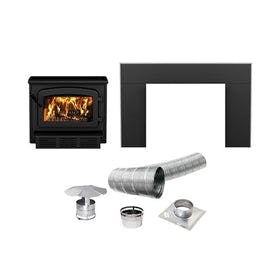
Flame Retardants: What Are They and Are They Safe?
Last Updated: Feb 26, 2025Most homeowners have probably heard about the potential dangers of volatile organic compounds, or VOCs, lurking inside your home. As people gain awareness of the genuine risks that chemicals and other potential pathogens in your home's indoor air quality pose, low-VOC products are understandably growing in popularity. Check out this complete Rise guide for how you can protect your home's indoor air quality by minimizing VOCs in your home.
Purchasing low-VOC paint is certainly a good starting point. But, there are dozens of other products in your home that might also be negatively affecting your health. Flame retardants are common in dozens of standard household products. They could be leaching unhealthy chemicals into your home's environment.
Table of Contents
- What Are Flame Retardants?
- How Do Flame Retardants Work?
- Are Fire Retardants Bad for Your Health?
- What Flame Retardant Regulations Exist?
- Country Of Origin Factors
- Are Brominated Flame Retardants Toxic When Inhaled?
- Where Are Flame Retardants Found?
- How Can Flame Retardants Be Avoided?
- Are Some Flame Retardants Safer Than Others?
- Can Flame Retardants Be Washed Out?
- How Are Mattresses Without Flame Retardants Fireproof?

What Are Flame Retardants?
A study by Duke University found that the most commonly used commercial flame retardant chemicals are increasingly showing up in human urine samples in adults across the United States. The study mentions "ubiquitous human exposure" to these potentially dangerous chemicals and found that human exposure to these chemicals steadily increased in samples collected between 2002 and 2015. But why does this matter?
Flame retardants are certain substances that are added to different combustible materials to prevent fires from starting. They can also help to slow the spread of fire once they occur. Boric acid is a less toxic, natural example (though it comes with its risks). For hundreds of years, it has been used by peasant and indigenous populations in Central America who use bamboo for home construction. Flame retardants can significantly reduce the risk of devastating house fires or limit the scope of damage if a fire occurs.
As we will see below, many government, state, and local agencies mandate flame retardants in certain household products. They do this to protect homeowners and limit insurance liability claims when fires occur. However, many of the most widely used flame retardants could pose a significant risk to human health.
How Do Flame Retardants Work?
The actual mechanism by which flame retardants work to avoid or limit a fire's scope depends on the flame retardant used. Returning to borax, the boric acid in this product can release water when exposed to extreme heat. This excess moisture can help to extinguish the fire. Boric acid can also help form a char on the cellulose surfaces found in wood and certain fabrics. This char slows the spread of fire.
Brominated flame retardants are commonly used in household products, from mattresses to carpets and everything in between. One of the reasons that brominated flame retardants are so popular is their efficiency at limiting fire. In technical terms, bromine has what is known as "vapor phase inhibition properties." When a fire occurs, the bromine is heated and releases the bromine atom during the gas phase. This property helps stop or significantly slow the fire before reaching its "ignition temperature" when a fire begins to expand.

Are Fire Retardants Bad for Your Health?
Though several different flame retardants' fire-repressing properties might seem like a great invention, they also come with several health concerns. Many of the most commonly used flame retardants will slowly leach out of the products and into the surrounding environment. These chemicals have been shown to bio-accumulate in nature, primarily affecting marine ecosystems.
As flame retardants leach out of your furniture, carpeting, electronics, and other everyday household items, they are absorbed into the human body through the skin, by breathing VOCs, and by swallowing. Organophosphate flame retardants have been shown to cause several adverse health effects. Studies reported by the NIEHS have linked human exposure to organophosphate to several serious health problems, including:
- Endocrine and thyroid disruption
- Impacts on the immune system
- Reproductive toxicity
- Cancer
- Adverse effects on fetal and child development
- Neurologic function
What Flame Retardant Regulations Exist?
Government regulation of flame retardants falls into two main categories: regulation to reduce flammability and regulation against certain dangerous flame retardants due to human health concerns. Local and state laws and building codes will most likely determine what products will require flame retardants to reduce fire risk.
Due to human health concerns, most regulation has focused on polybrominated diphenyl ethers or PBDE flame retardants. Unlike other organophosphate flame retardants, PBDEs are chemicals incapable of binding with the products they are added to. This characteristic means that they are most easily released from products and into the air, dust, and other airborne particles. Studies have shown that inhaled PBDEs can reduce children's birth weight and length and impair neurological development.
Because of this volatility and the adverse health effects, PBDE bans have been in place in Canada since 2008 and the US and the European Union since 2004. Other bromine-containing flame retardants such as Deca-DBE were phased out of production, importation, and sales in 2013.
Despite these well-intentioned bans on PBDEs, experts believe that they will continue to release significant amounts of dangerous chemicals into the environment. This continued release is due to existing products in the home and importing products from countries with less stringent regulations. On a positive note, however, Scientific American reported that detectable levels of fire retardant chemicals are beginning to decline in women for the first time in years.
Are Brominated Flame Retardants Toxic When Inhaled?
One of the main dangers associated with brominated flame retardants is that they are highly volatile. This volatility means they can be released into the surrounding air and subsequently inhaled by people inside homes. According to one study, the main pathways of exposure to brominated flame retardants occur via consuming contaminated food, ingestion, and inhalation of dust. Other types of flame retardants that can be potentially toxic when inhaled include halogenated flame-retardants (HFRs).

Where Are Flame Retardants Found?
The National Institute of Environmental Health Sciences (NIEHS) has identified the presence of flame retardants in dozens of different household products such as:
- Home furniture and furnishings such as Memory foam, upholstery, mattresses, carpets, curtains, and fabric blinds
- Electronic devices, such as computers, laptops, phones, televisions, and household appliances, plus wires and cables
- Building and construction materials, including insulation materials, especially foams that contain polystyrene and polyurethane insulation foams.

How Can Flame Retardants Be Avoided?
Besides avoiding products made in China or other countries that have not implemented policies banning the use of PBDEs, what else can you do to prevent PBDEs in your home?
Firstly, you should prioritize not purchasing any upholstered furniture with polyurethane foam and has a label stating it meets the California furniture flammability standard as outlined in the technical Bulletin 117(TB117). This label requires foam-based furniture to incorporate potentially health-damaging flame retardants. Also, avoid purchasing baby or toddler products such as nursing pillows, strollers, baby carriers made in China, or the TB117 label.

You can also reduce exposure to PBDEs found in electronics by only purchasing from companies pledged to produce PBDE-free electronic products. Brands that have signed on to this pledge include:
- Acer
- Apple
- Eizo Nanao
- LG Electronics
- Lenovo
- Matsushita
- Microsoft
- Nokia
- Phillips
- Samsung
- Sharp
- Sony-Ericsson
- Toshiba
To find out more about how your family can avoid the worst flame retardants in different products in your home, check out these Rise articles on healthy home furnishings, healthy sofa and sectionals, and healthy nurseries.
Are Some Flame Retardants Safer Than Others?
Another way to reduce exposure to potentially harmful brominated flame retardants is to search for products known to cause less harmful health consequences. As we mentioned above, boric acid is one of the safer alternatives. Recent exciting research reveals the opportunity to replace chemical flame retardants with bio-based coatings made from casein (clay), crab shells, and other substances. While these products are still in testing, there is a good possibility that healthier, bio-based flame retardants will be used in household products in the coming years.
Can Flame Retardants Be Washed Out?
What can you do if you have already purchased products that potentially contain PBDEs or other dangerous flame retardants? Firstly, to avoid ingestion, make sure not to allow children or toddlers to put electronics, textiles, or other products with flame-retardant in their mouth. For materials and other fabrics, thorough washing can reduce the level of flame retardants present. However, there is a high probability that traces will remain.

How Are Mattresses Without Flame Retardants Fireproof?
It is crucial to recognize that flame retardants do not make materials completely fireproof. In the event of a significant house fire, even mattresses doused in PBDEs will most likely eventually succumb to the flames. Still, flame retardants can help to delay the spread of fire. If, for example, you drop a candle on your mattress, flame retardants can help slow the spread of a fire, giving you time to react before a disaster occurs.
Natural materials, like wool and natural latex, and organic cotton, have inherent flame-resistant properties. For this reason, they don't need to have any additional flame retardants added.

As is often the case, smart and straightforward prevention techniques (such as not falling asleep with a lit candle next to your bed) are often a safer alternative.
Tobias Roberts
Tobias runs an agroecology farm and a natural building collective in the mountains of El Salvador. He specializes in earthen construction methods and uses permaculture design methods to integrate structures into the sustainability of the landscape.











